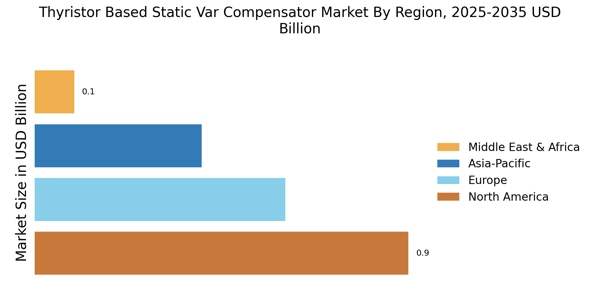Rising Demand for Industrial Automation
The Thyristor Based Static Var Compensator Market is witnessing growth driven by the rising demand for industrial automation. As industries strive for higher efficiency and productivity, the need for reliable power quality becomes critical. Thyristor-based solutions offer precise control over reactive power, which is essential for the optimal operation of automated systems. The increasing adoption of automation technologies across various sectors, including manufacturing and process industries, is likely to propel the demand for static var compensators. This trend indicates that the Thyristor Based Static Var Compensator Market is well-positioned to capitalize on the ongoing industrial transformation.
Advancements in Power Electronics Technology
Technological advancements in power electronics are playing a crucial role in the Thyristor Based Static Var Compensator Market. Innovations in semiconductor materials and control algorithms have led to more efficient and compact designs. These advancements enable better performance and reliability of thyristor-based systems, which are essential for modern power applications. The integration of smart grid technologies further enhances the capabilities of static var compensators, allowing for real-time monitoring and control. As a result, the Thyristor Based Static Var Compensator Market is poised for growth, with manufacturers focusing on developing next-generation solutions that meet the evolving demands of the energy sector.
Growing Investment in Smart Grid Infrastructure
Investment in smart grid infrastructure is a significant driver for the Thyristor Based Static Var Compensator Market. As utilities modernize their grids to enhance efficiency and reliability, the need for advanced power quality solutions becomes evident. Thyristor-based static var compensators play a vital role in smart grids by providing dynamic voltage support and improving overall system performance. Recent reports indicate that global investments in smart grid technologies are on the rise, which bodes well for the Thyristor Based Static Var Compensator Market. This trend highlights the increasing recognition of the importance of robust power management solutions in the transition to smarter energy systems.
Increasing Need for Reactive Power Compensation
The Thyristor Based Static Var Compensator Market is experiencing a surge in demand due to the increasing need for reactive power compensation in electrical systems. As industries expand and urbanization accelerates, the requirement for stable voltage levels becomes paramount. Thyristor-based solutions provide rapid response times and high efficiency, making them ideal for maintaining power quality. According to recent data, the market for reactive power compensation is projected to grow significantly, driven by the need to enhance grid reliability and reduce transmission losses. This trend indicates that the Thyristor Based Static Var Compensator Market is likely to witness substantial growth as utilities and industries seek to optimize their power systems.
Regulatory Support for Renewable Energy Integration
The Thyristor Based Static Var Compensator Market is benefiting from regulatory support aimed at facilitating the integration of renewable energy sources. Governments are increasingly implementing policies that promote the use of clean energy, which often requires advanced power management solutions. Thyristor-based static var compensators are essential for managing the variability of renewable energy sources, ensuring grid stability and reliability. As the share of renewables in the energy mix continues to rise, the demand for these compensators is expected to increase. This regulatory environment suggests a favorable outlook for the Thyristor Based Static Var Compensator Market, as stakeholders seek to comply with sustainability goals.


















Leave a Comment